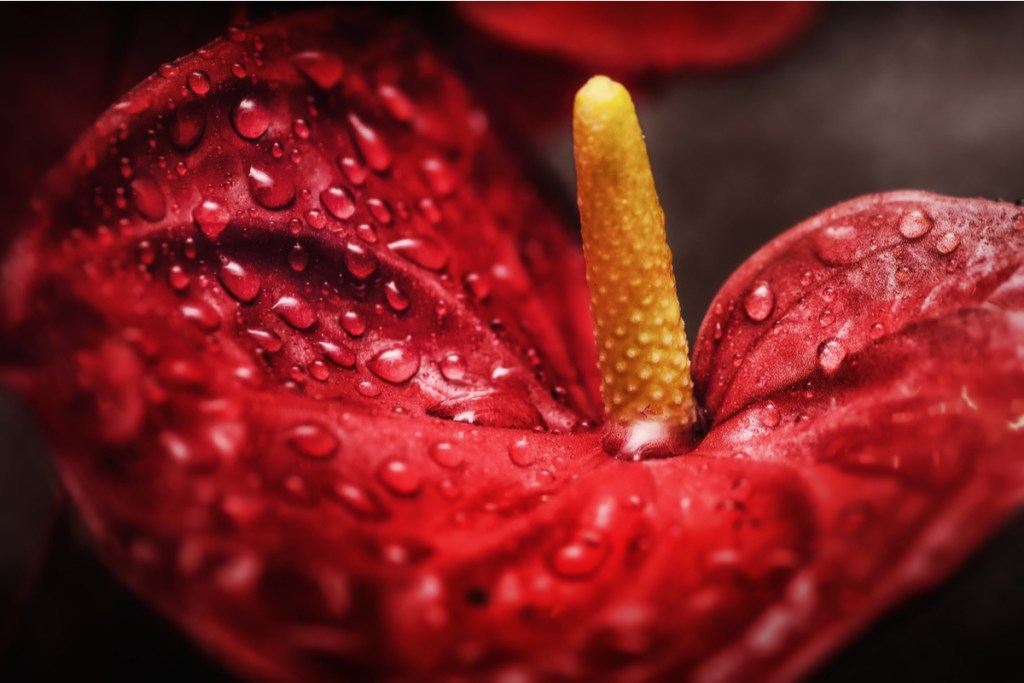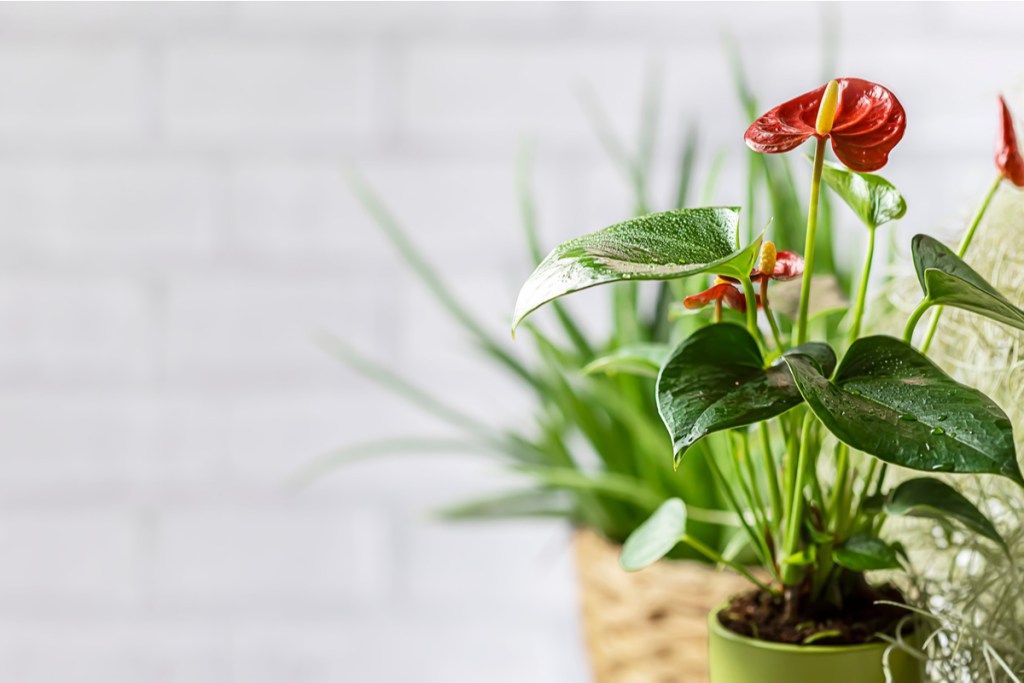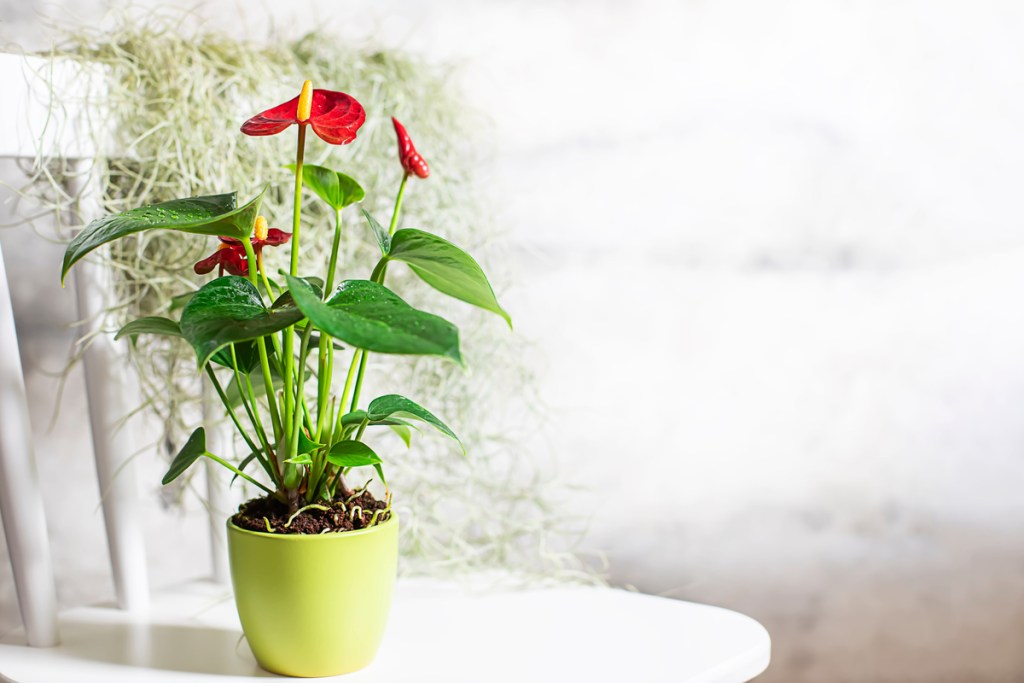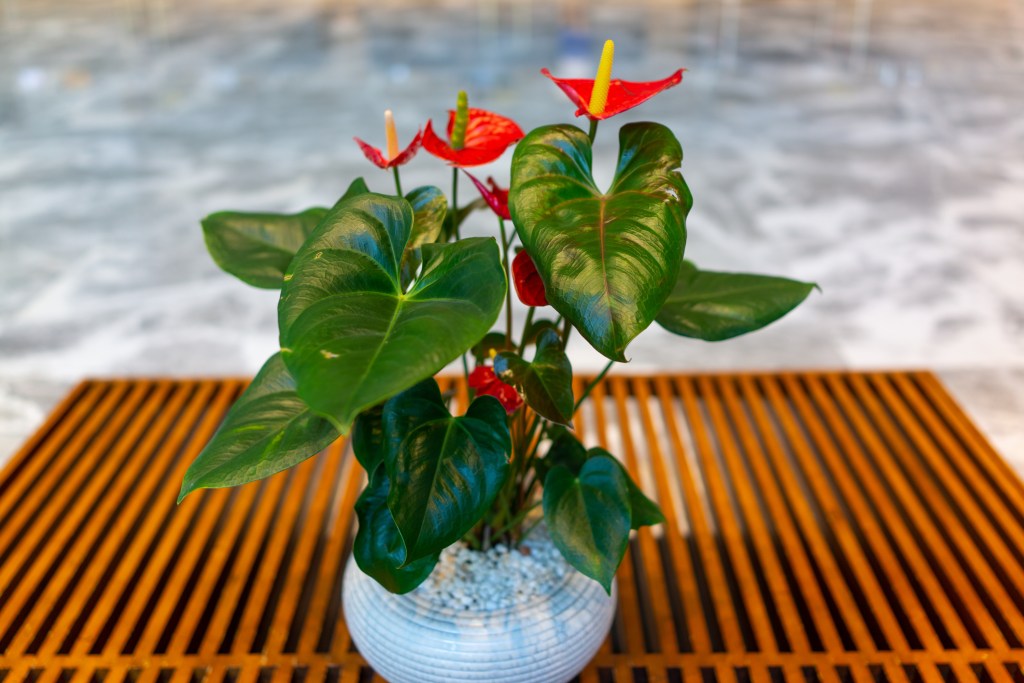There are roughly 1,000 species of anthurium plants, which are native to Central America, South America, and the Caribbean. They’re perennials, and although they can grow outdoors in warmer climates, they’re one of the most compatible houseplants for indoor spaces and often seen in indoor garden collections.
Anthurium plants are hardy in zones 10 and higher. Red anthuriums are very common, but you can find white and pink plants and even plants that are shades of yellow, burgundy, and green. Some gardeners grow them to admire their foliage, while others like them for the beautiful colors the anthurium has to offer.
But be aware that this plant — also known as the “flamingo flower” — can be fussy. As most plants do, the anthurium needs certain care conditions to be met in order to really thrive. You may end up doing a bit of trial and error, but it will be worth it to have this beautiful plant in your home. So, how do you care for an anthurium plant indoors?

Is it easy to grow anthurium plants indoors?
As with most indoor plants, your anthurium will do best when potted with well-draining soil in a container that has good drainage. Follow these steps for growing your plant indoors:
Step 1: Keep the soil moist when watering, but not wet (as you don’t want your anthurium sitting in soggy soil and potentially rotting).
Step 2: Use a pot that the anthurium can grow into instead of out of, to avoid repotting too much.
Step 3: Repot when you see roots begin to come above the soil.
Step 4: Provide your anthurium with some additional support in the form of a garden stake or skewer if it has trouble supporting itself.
When they grow in their natural environment, anthuriums tend to grow off other plants instead of in soil. This can lead to difficulty staying upright when in soil.

How do you water anthurium plants?
Anthuriums prefer an environment in which the soil is moist, not wet, and never dries out completely. Since they prefer a moist environment, anthuriums will require regular watering. Be wary of overwatering and drowning the plant. Anthuriums are prone to root rot if the soil is too wet for too long.
On the other hand, allowing the soil to dry out too much will slow the growth of the plant and make it more difficult for the roots to become wet again. Unlike hardy houseplants, the anthurium is one that needs close monitoring to ensure you’re providing it with the care it needs.
Here's how to make sure they get the right amount of water:
Step 1: Use a pot with good drainage.
Step 2: Avoid overwatering your anthurium by paying close attention to when the water begins to seep out the bottom and into the tray.
Step 3: Water again when the top of the soil is dry to the touch.

What type of soil do anthuriums prefer?
Anthuriums need the soil to drain well but be able to hold some water so that it stays moist. This is how to choose the best soil for them:
Step 1: Use a well-draining soil and a pot with a drainage hole.
Step 2: Use a potting mix designed for orchids with some additional sand and peat moss.
Step 3: Try a half-and-half mixture of regular houseplant potting soil and orchid mix if you are unable to add sand and peat moss.
This gives you a similar environment to the one with sand and peat moss, and your anthurium will still be happy.

What’s the best light for anthuriums?
Anthuriums can grow in all levels of indirect lighting, so if you live in a dimmer space, you still have a shot at keeping an anthurium as a houseplant. Here's how to choose the best lighting for your anthurium:
Step 1: Keep in mind that anthuriums grown in lower lighting will grow slower and have fewer flowers than those grown in bright, indirect lighting.
Step 2: Don't place your plant in direct lighting. Anthuriums have a low tolerance for direct sunlight, and their leaves will easily burn.
Step 3: Put your anthurium in bright, indirect light for the best growing environment.
Step 4: Use a grow light as a supplement if you don't have the right natural lighting.

What if the anthurium isn’t blooming?
Like we said — anthuriums can be a bit trickier. If the anthurium isn’t blooming, it may be because it isn’t getting the exact mixture of humidity, light, water, and nutrients from its potting mixture that it requires. Here's how to find and correct the problem:
Step 1: Troubleshoot first by making sure you’re following the directions, as listed above.
Step 2: Fertilize the plant occasionally — about once every one to two weeks.
Step 3: Use a phosphorus-rich fertilizer diluted to quarter strength.
Step 4: Keep in mind that anthuriums should be repotted every two to three years, to make sure they have room to continue growing and pushing out new blooms.

Can I propagate anthuriums?
Yes! And doing so when you repot is the perfect time. Here's what to do:
Step 1: Take a stem cutting that has at least two nodes.
Step 2: Root it in water or perlite, or push it directly in the soil.
The cutting may take some time to grow, but so long as you’re patient, you’ll be sure to see results.
Remember that anthuriums are still tropical plants. Proper anthurium care means they need to grow in humid, moist environments. Recreating these conditions as best you can will give your anthurium the best shot at thriving. When it’s colder/drier out, you’ll want to mist your plant to increase humidity levels or even run a humidifier.
Editors' Recommendations
- Everything you need to know about trailing succulents care for lush, thick growth
- How to pick the perfect orchid pots for healthy blooms
- Beyond basil and cilantro, add these unique plants to your indoor herb garden
- Beautiful, low-maintenance pothos varieties to add to your plant collection
- 5 easy-care spider plant varieties perfect for any home garden



